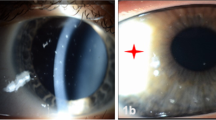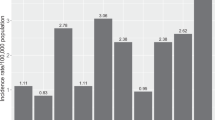Abstract
Purpose
To study the clinical characteristics and treatment outcomes of ocular surface pseudoepitheliomatous hyperplasia (PEH) associated with chronic vernal keratoconjunctivitis (VKC).
Methods
This retrospective study includes 39 eyes of 32 patients with VKC induced PEH who presented from 2016–2022. A database search was conducted for diagnosis of PEH, and data on clinical features, imaging characteristics, and treatment were analyzed.
Results
Of the 32 patients, 11 (34%) were children and adolescents, 21 (66%) were adults. PEH was common in males (72%) and ocular surface squamous neoplasia (OSSN) was the commonest referral diagnosis (43.7%). Mean age at presentation was 26.62 ± 10.18 (range: 6–52) years. While history of VKC was present in 21 patients, 11 were diagnosed with VKC at the time of diagnosis of PEH. The mean base/largest diameter was 5.2 ± 1.67 mm. Anterior segment optical coherence tomography (AS-OCT) showed irregular hyper-reflective epithelium, epithelial dipping, and sub-epithelial hyper-reflective lesion with shadowing in all lesions. Of the 31 eyes that received medical therapy, 21 (67%) and 10 (32%) eyes showed complete and partial resolution respectively with median time to resolution of 3(IQR:2–4) months. Eight eyes that underwent surgical excision showed complete resolution and one developed partial limbal stem cell deficiency.
Conclusion
Ocular surface PEH is a manifestation of chronic VKC which closely mimics OSSN. Detailed history-taking, examination for signs of allergy, and AS-OCT imaging can distinguish it from OSSN. It responds well to medical therapy and should be considered first-line therapy before planning any surgical intervention.
This is a preview of subscription content, access via your institution
Access options
Subscribe to this journal
Receive 18 print issues and online access
$259.00 per year
only $14.39 per issue
Buy this article
- Purchase on Springer Link
- Instant access to full article PDF
Prices may be subject to local taxes which are calculated during checkout




Similar content being viewed by others
Data availability
Data available on request.
References
Shields CL, Shields JA. Tumors of the conjunctiva and cornea. Surv Ophthalmol. 2004;49:3–24.
Honavar SG, Manjandavida FP. Tumors of the ocular surface: a review. Indian J Ophthalmol. 2015;63:187–203.
Mortada A. Pseudo-epitheliomatous hyperplasia of cornea, conjunctiva, and eyelid. Br J Ophthalmol. 1962;46:248–50.
Malhotra C, Jain AK, Thapa B. Limbal pseudoepitheliomatous hyperplasia mimicking ocular surface squamous neoplasia in palpebral vernal keratoconjunctivitis. Case Rep. Ophthalmol Med. 2013;2013:1–3.
Schwab IR, Schwab L, Cavender JC. Limbal vernal keratoconjunctivitis with a hypertrophic limbal mass lesion. Ann Ophthalmol. 1987;19:79–80.
Fatima A, Matalia HP, Vemuganti GK, Honavar SG, Sangwan VS. Pseudoepitheliomatous hyperplasia mimicking ocular surface squamous neoplasia following cultivated limbal epithelium transplantation. Clin Exp Ophthalmol. 2006;34:889–91.
Kaliki S, Maniar A, Jakati S, Mishra DK. Anterior segment optical coherence tomography features of pseudoepitheliomatous hyperplasia of the ocular surface: a study of 9 lesions. Int Ophthalmol. 2021;41:113–9.
Williams K, Thomson D, Seto I, Contopoulos-Ioannidis DG, Ioannidis JP, Curtis S, et al. Child Health Group. Standard 6: age groups for pediatric trials. Pediatrics. 2012;129:S153–60.
Mohebbi M, Ameli K, Mafi M, Bashiri A, Mahbod M. Pseudoepitheliomatous Hyperplasia as a Limbal Mass Mimicking Nodular Episcleritis. Korean J Ophthalmol. 2016;30:148–9.
Margo CE, Grossniklaus HE. Pseudoadenomatous hyperplasia of the conjunctiva. Ophthalmology. 2001;108:135–8.
Rao SK, Meenakshi S, Srinivasan B, Baluswamy S. Perilimbal bulbar conjunctival pigmentation in vernal conjunctivitis: prospective evaluation of a new clinical sign in an Indian population. Cornea. 2004;23:356–9.
Sangwan VS, Jain V, Vemuganti GK, Murthy SI. Vernal keratoconjunctivitis with limbal stem cell deficiency. Cornea. 2011;30:491–6.
Das AV, Donthineni PR, Sai Prashanthi G, Basu S. Allergic eye disease in children and adolescents seeking eye care in India: electronic medical records driven big data analytics report II. Ocul Surf. 2019;17:683–9.
Vempuluru VS, Jakati S, Godbole A, Mishra DK, Mohamed A, Kaliki S. Spectrum of AS-OCT features of ocular surface tumors and correlation of clinico-tomographic features with histopathology: a study of 70 lesions. Int Ophthalmol. 2021;41:3571–86.
Donthineni PR, Varma S, Kethiri A, Shanbhag S, Mishra DK, Singh V, et al. Histopathological characteristics of limbal stem cell deficiency secondary to chronic vernal keratoconjunctivitis. Cornea. 2022;41:722–8.
Dua HS, Saini JS, Azuara-Blanco A, Gupta P. Limbal stem cell deficiency: concept, aetiology, clinical presentation, diagnosis, and management. Indian J Ophthalmol. 2000;48:83–92.
Lyall DAM, Srinivasan S, Roberts F. Limbal stem-cell failure secondary to advanced conjunctival squamous cell carcinoma: A clinicopathological case report. BMJ Case Rep. 2009;2009:bcr0920092272.
Kaliki S, Mohammad FA, Tahiliani P, Sangwan VS. Concomitant simple limbal epithelial transplantation after surgical excision of ocular surface squamous neoplasia. Am J Ophthalmol. 2017;174:68–75.
Shanbhag SS, Chanda S, Donthineni PR, Basu S. Surgical management of unilateral partial limbal stem cell deficiency: conjunctival autografts versus simple limbal epithelial transplantation. Clin Ophthalmol. 2021;15:4389–97.
Acknowledgements
The authors would like to acknowledge the support extended by Mr. Chenchu Naidu Gorrepati, Mr. Sreedhar Rao Boyinpally and Mr Tirupathy for their assistance during the processing of the histopathological specimens in the ophthalmic pathology laboratory, L.V. Prasad Eye Institute.
Funding
This work was funded by the Hyderabad Eye Research Foundation, Hyderabad, India. The sponsoring organization had no role in the design or conduct of this research. (Ethics Ref No LEC-BHR-R-06-23-1078).
Author information
Authors and Affiliations
Contributions
Concept and design of study or acquisition of data or analysis and interpretation of data–AN, SJ, SB, SK, PRD. Drafting the article or revising it critically for important intellectual content- AN, SS, SJ, SB, SK, PRD. Final approval of the version to be published–AN, SS, SJ, SB, SK, PRD, The manuscript has been read and approved by all the authors, the requirements for authorship as stated above have been met, and each author believes that the manuscript represents honest work.
Corresponding author
Ethics declarations
Competing interests
The authors declare no competing interests.
Additional information
Publisher’s note Springer Nature remains neutral with regard to jurisdictional claims in published maps and institutional affiliations.
Rights and permissions
Springer Nature or its licensor (e.g. a society or other partner) holds exclusive rights to this article under a publishing agreement with the author(s) or other rightsholder(s); author self-archiving of the accepted manuscript version of this article is solely governed by the terms of such publishing agreement and applicable law.
About this article
Cite this article
Nibandhe, A., Kaliki, S., Jakati, S. et al. Ocular surface pseudoepitheliomatous hyperplasia secondary to allergic eye disease: clinical features and management. Eye (2023). https://doi.org/10.1038/s41433-023-02897-y
Received:
Revised:
Accepted:
Published:
DOI: https://doi.org/10.1038/s41433-023-02897-y



